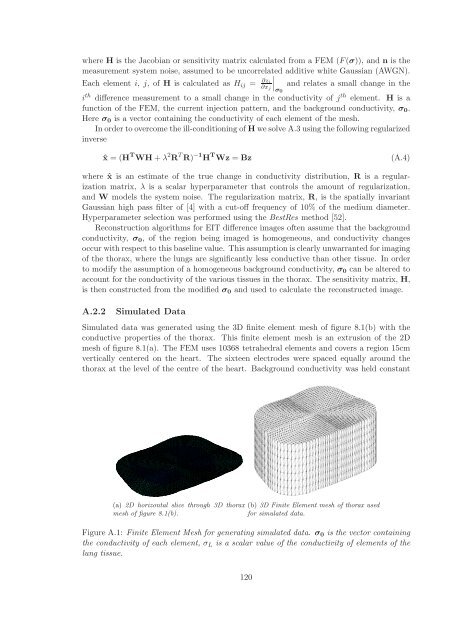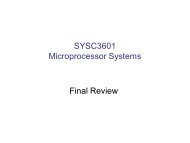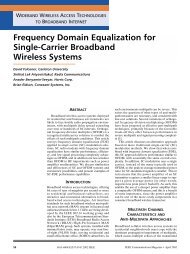Image Reconstruction for 3D Lung Imaging - Department of Systems ...
Image Reconstruction for 3D Lung Imaging - Department of Systems ...
Image Reconstruction for 3D Lung Imaging - Department of Systems ...
You also want an ePaper? Increase the reach of your titles
YUMPU automatically turns print PDFs into web optimized ePapers that Google loves.
where H is the Jacobian or sensitivity matrix calculated from a FEM (F(σ)), and n is the<br />
measurement system noise, assumed to be uncorrelated additive white Gaussian (AWGN).<br />
Each element i, j, <strong>of</strong> H is calculated as Hij = ∂zi<br />
�<br />
�<br />
and relates a small change in the<br />
� ∂xj σ0<br />
i th difference measurement to a small change in the conductivity <strong>of</strong> j th element. H is a<br />
function <strong>of</strong> the FEM, the current injection pattern, and the background conductivity, σ0.<br />
Here σ0 is a vector containing the conductivity <strong>of</strong> each element <strong>of</strong> the mesh.<br />
In order to overcome the ill-conditioning <strong>of</strong> H we solve A.3 using the following regularized<br />
inverse<br />
ˆx = (H T WH + λ 2 R T R) −1 H T Wz = Bz (A.4)<br />
where ˆx is an estimate <strong>of</strong> the true change in conductivity distribution, R is a regularization<br />
matrix, λ is a scalar hyperparameter that controls the amount <strong>of</strong> regularization,<br />
and W models the system noise. The regularization matrix, R, is the spatially invariant<br />
Gaussian high pass filter <strong>of</strong> [4] with a cut-<strong>of</strong>f frequency <strong>of</strong> 10% <strong>of</strong> the medium diameter.<br />
Hyperparameter selection was per<strong>for</strong>med using the BestRes method [52].<br />
<strong>Reconstruction</strong> algorithms <strong>for</strong> EIT difference images <strong>of</strong>ten assume that the background<br />
conductivity, σ0, <strong>of</strong> the region being imaged is homogeneous, and conductivity changes<br />
occur with respect to this baseline value. This assumption is clearly unwarranted <strong>for</strong> imaging<br />
<strong>of</strong> the thorax, where the lungs are significantly less conductive than other tissue. In order<br />
to modify the assumption <strong>of</strong> a homogeneous background conductivity, σ0 can be altered to<br />
account <strong>for</strong> the conductivity <strong>of</strong> the various tissues in the thorax. The sensitivity matrix, H,<br />
is then constructed from the modified σ0 and used to calculate the reconstructed image.<br />
A.2.2 Simulated Data<br />
Simulated data was generated using the <strong>3D</strong> finite element mesh <strong>of</strong> figure 8.1(b) with the<br />
conductive properties <strong>of</strong> the thorax. This finite element mesh is an extrusion <strong>of</strong> the 2D<br />
mesh <strong>of</strong> figure 8.1(a). The FEM uses 10368 tetrahedral elements and covers a region 15cm<br />
vertically centered on the heart. The sixteen electrodes were spaced equally around the<br />
thorax at the level <strong>of</strong> the centre <strong>of</strong> the heart. Background conductivity was held constant<br />
(a) 2D horizontal slice through <strong>3D</strong> thorax<br />
mesh <strong>of</strong> figure 8.1(b).<br />
(b) <strong>3D</strong> Finite Element mesh <strong>of</strong> thorax used<br />
<strong>for</strong> simulated data.<br />
Figure A.1: Finite Element Mesh <strong>for</strong> generating simulated data. σ0 is the vector containing<br />
the conductivity <strong>of</strong> each element, σL is a scalar value <strong>of</strong> the conductivity <strong>of</strong> elements <strong>of</strong> the<br />
lung tissue.<br />
120





